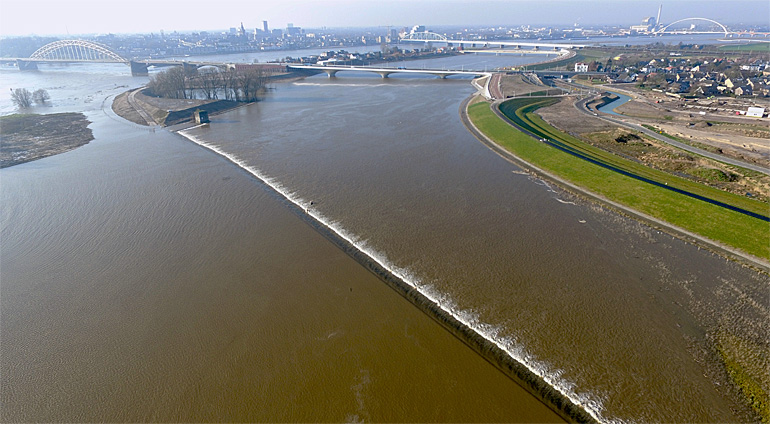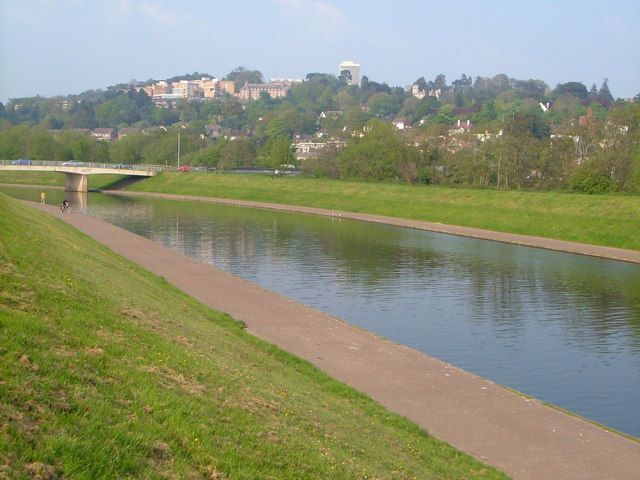Definition
Bypass channel, also known as a flood-relief channel, is an artificially made waterway constructed in order to protect urban and rural agricultural areas from flooding. It is built to carry excess water from a main stream or river so that it is translocated into the lower parts of the same stream or into another stream with the ability to accept a large amount of excess water. There are two types of bypass channels with regards to placement: parallel and transverse (vertical). The most common case of a parallel bypass channel is the one starting from the main river before the flood-prone section and reunited with the river after that section. In lowland areas, the construction of bypass channels is often combined with the construction of retention areas (Ahmad P. and Rasool S., 2014, p. 304).Co-benefits and impacts
Apart from enhancing the rivers' capacity, many secondary benefits are produced such as increasing groundwater infiltration, improving water quality, restoring natural floodplain forming processes (e.g., sediment transport and deposition) and improving fish and wildlife habitats.(FEMA, Floodplain Natural Resources and Functions, accessed on Sept. 2016)
Definition (GR)
Το κανάλι παράκαμψης, επίσης γνωστό ως κανάλι ανακούφισης από πλημμύρες, είναι μια τεχνητή υδάτινη οδός κατασκευασμένη για να προστατεύει τις αστικές και αγροτικές περιοχές από τις πλημμύρες. Είναι κατασκευασμένο για να μεταφέρει περίσσεια νερού από ένα κύριο ρεύμα ή ποτάμι έτσι ώστε να μετατοπίζεται στα κάτω μέρη του ίδιου ρεύματος ή σε ένα άλλο ρεύμα με την ικανότητα να δέχεται μεγάλη ποσότητα υπερβολικού νερού. Υπάρχουν δύο τύποι καναλιών παράκαμψης όσον αφορά την τοποθέτηση: παράλληλοι και εγκάρσιοι (κάθετοι). Η πιο συνηθισμένη περίπτωση ενός παράλληλου καναλιού παράκαμψης είναι αυτή που ξεκινά από τον κύριο ποταμό πριν από το τμήμα που είναι επιρρεπές σε πλημμύρες και επανενώνεται με το ποτάμι μετά από αυτό το τμήμα. Στις περιοχές των πεδινών περιοχών, η κατασκευή καναλιών παράκαμψης συνδυάζεται συχνά με την κατασκευή περιοχών διατήρησης (Ahmad P. and Rasool S., 2014, p. 304).Co-benefits and impacts (GR)
Εκτός από την βελτίωση της χωρητικότητας των ποταμών, παράγονται πολλά δευτερεύοντα οφέλη, όπως η αύξηση της διήθησης των υπόγειων υδάτων, η βελτίωση της ποιότητας των υδάτων,αποκατάσταση φυσικών διαδικασιών σχηματισμού πλημμυρικών πεδίων (π.χ. μεταφορά και εναπόθεση ιζημάτων) και η βελτίωση των οικοτόπων ψαριών και άγριων ζώων. (FEMA, Floodplain Natural Resources and Functions, accessed on Sept. 2016)Case study
Last modified: July 2, 2020, 7:15 p.m.


 Ελληνικά
Ελληνικά


